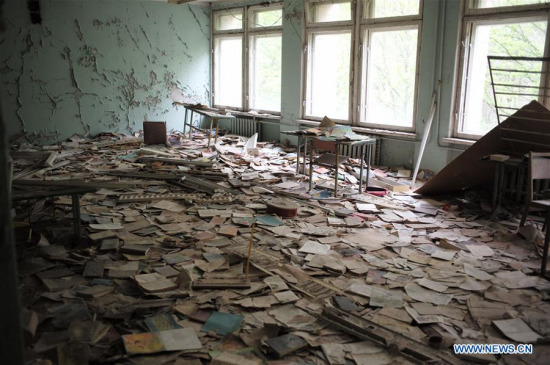
hoto taken on April 19, 2016 shows a deserted school in Pripyat city near Chernobyl, Ukraine. Chernobyl, a place replete with horrific memories in northern Ukraine, close to Belarus, is now open to tourists, almost 30 years to the date after a nuclear power plant there exploded. (Photo: Xinhua/Dai Tianfang)
The Xinhua correspondent saw a large tract of forest around the ruined nuclear power plant, and some wild horses and deer. Andrew said that those animals had been there before the nuclear accident happened.
As for the forest, Andrew said that there are also a lot of forests in other places in Ukraine and that the forest area in the country has not been reduced by the disaster.
Nuclear radiation is known to kill animals and human beings in a very short time, and many abnormal newborns of human beings and animals in the disaster area have been reported.
But Andrew denied some media reports that there were mass propagations of animals or rampages of monsters in the forbidden zone.
Tourists can use bread crumbs to feed fish from an iron bridge in the zone. Although fishing is banned in the zone, feeding fish is allowed as part of the tour program to entertain tourists.
Pripyat, a city near the Chernobyl nuclear power plant, was built for the plant's workers and opened in 1970 after the nuclear power plant was put into operation.
Now, the former energy city has become a "ghost town," with trees and grass growing wildly everywhere, even inside the ruined shops, cultural center, restaurants and hotels.
In the center of the city, a rusty ferris wheel still stands in a cultural park. A football stadium, beside the park, has turned into woods, with wooden chairs rotting on the stands. In a school, dusty and shabby desks and stools were everywhere, and textbooks, stationery and glass shards were scattered on the ground.
Some members of rescue teams had stayed in the city during the first ten years after the accident took place. They worked to contain the pollution and clean the contaminated soil.
On a square in front of the No. 4 reactor of the plant stands a sculpture, reminding people to pay close attention to the peaceful use of nuclear energy as well as its safety.
After the horrific events in Chernobyl, researchers in countries around the world have become more vigilant. Now, the security of some 400 nuclear power plants around the world has greatly improved, with safer ones being successively put into operation.


















































